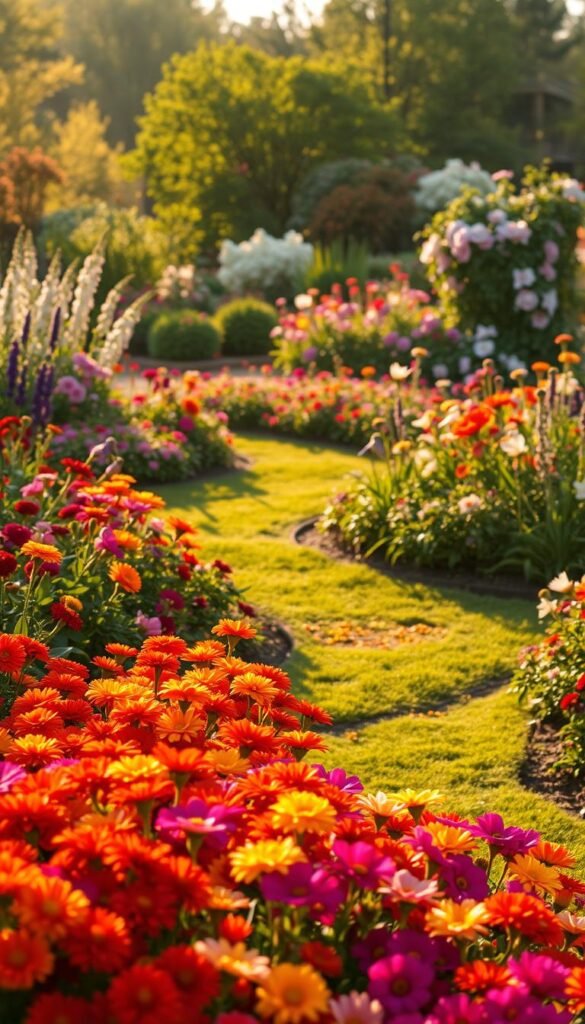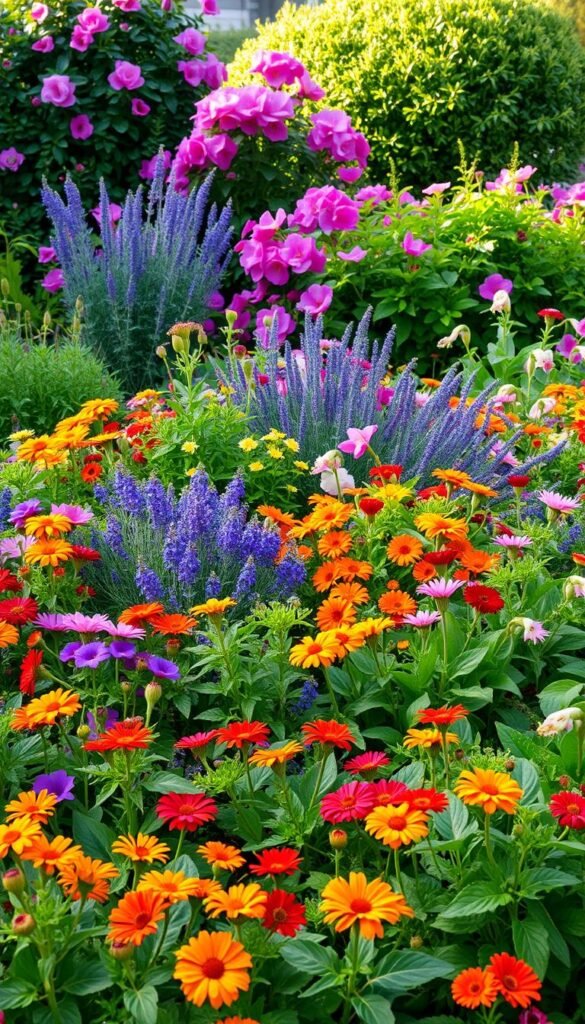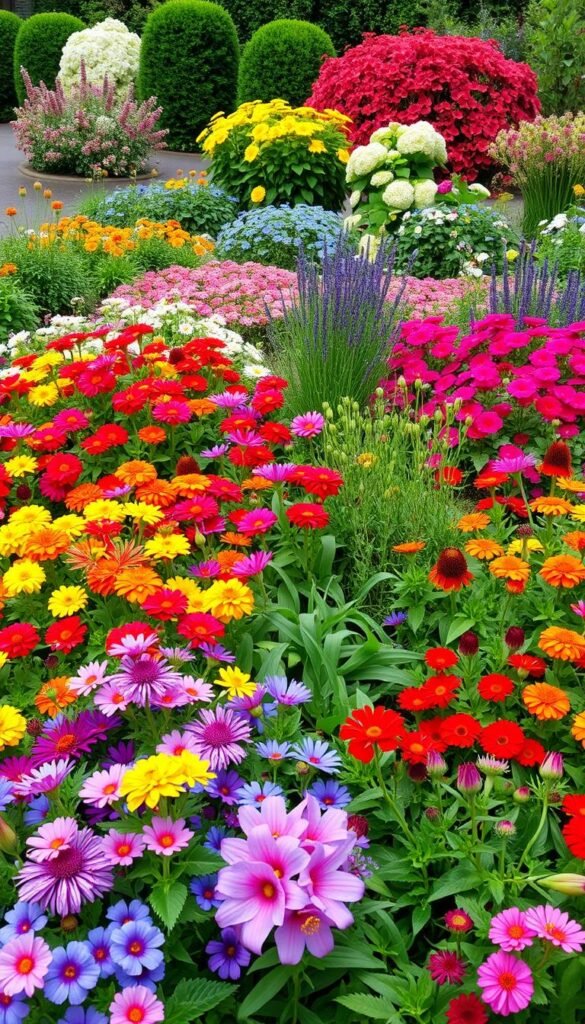Ever wonder why some outdoor spaces look effortlessly put together while others appear chaotic? The secret lies in thoughtful arrangement rather than random placement. Professional designers create visual harmony by grouping varieties in bold clusters, transforming ordinary yards into cohesive displays.
Many enthusiasts accidentally create disjointed spaces by collecting single specimens over time. This “onesie” approach leads to a jumbled appearance lacking rhythm. Instead, focus on repeating key varieties in drifts of three or five for natural flow.
A well-considered proven garden layout serves as your roadmap to success. It helps balance short-lived bloomers with reliable performers that return yearly. By mixing different plant types strategically, you’ll maintain color from spring through fall without overwhelming maintenance.
This guide reveals how to:
– Avoid common pitfalls that make spaces feel cluttered
– Use professional design techniques anyone can apply
– Select complementary varieties for extended interest
– Create focal points that draw the eye naturally
You’ll learn to edit your selections and arrange plants intentionally. The result? A vibrant outdoor area that evolves beautifully through the seasons while matching your care preferences. Let’s transform how you approach your space – one strategic grouping at a time.
Assessing Your Garden Space and Soil Quality

Creating a thriving planting area begins with understanding your unique environment. Sunlight patterns and soil composition vary across properties – factors that directly impact what will grow successfully. Let’s explore how to evaluate these elements before breaking ground.
Evaluating Sunlight and Shade in Your Garden
Track how light moves through your space over 24 hours. Morning sun differs from afternoon intensity – some varieties thrive in gentle rays but wilt under harsh midday exposure. Use a simple sun map: sketch your property and note shaded zones hourly.
Remember seasonal changes! Deciduous trees create shifting shade patterns. South-facing areas receive consistent light, while north-facing spots stay cooler. Match plant needs to these microclimates for healthier growth.
Testing Soil Health and Preparing Your Beds
Nutrient-rich earth forms the foundation for vibrant growth. Start with a basic test kit ($15-20 at garden centers) to measure pH and key minerals. For detailed insights, consider professional analysis through local agricultural extensions.
Improve your earth naturally:
- Mix compost into dense clay to enhance drainage
- Add organic matter to sandy soil for better moisture retention
- Apply 2-3 inches of mulch annually to maintain nutrient levels
Space plants according to mature sizes – crowded roots struggle to access water and nutrients. Allow breathing room between specimens for optimal air circulation and growth.
Vision and Layout: Creating a Vibrant Flower Garden

Great outdoor spaces tell stories through thoughtful design. Like painting with living materials, your planting area becomes a canvas where hues and forms interact. Start by visualizing how elements work together before selecting a single seedling.
Establishing a Color Palette and Texture Balance
Choose 3-4 dominant shades that harmonize. Cool purples and blues recede visually, while warm reds and oranges pop forward. Separate pastel groupings from bold hues using neutral foliage plants like lamb’s ear or ornamental grasses.
Mix leaf shapes for year-round appeal. Pair spiky iris blades with rounded hosta leaves. Add feathery astilbes beside glossy heuchera. This textural layering creates depth even when blooms fade.
Mapping Bloom Times for Seasonal Interest
Stagger flowering periods like a relay race. Early performers like bleeding heart give way to mid-summer phlox. Late stars such as sedum take the baton in fall. Try these combos:
- April tulips → June peonies → September asters
- May columbine → July daylilies → October chrysanthemums
Cosmos and zinnias serve as reliable anchors, blooming nonstop for 12+ weeks. Track what’s flowering monthly using a simple calendar. Spot gaps? Add bulbs or biennials to fill color voids.
“A garden should greet you with something new every fortnight.”
Rotate annuals in bare spots while perennials establish. This strategic approach ensures your space evolves beautifully from thaw to frost.
Essential Garden Design Principles for Blooming Success

Have you ever noticed how professional landscapes feel intentional while amateur plots often look scattered? The difference lies in applying core design strategies that guide the eye and create harmony. Let’s explore techniques that transform basic beds into captivating compositions.
Grouping Plants for Visual Impact
Odd-number clusters work like magic in design. Three coneflowers create a focal point. Five ornamental grasses form a flowing drift. This approach mimics nature’s patterns, where plants grow in colonies rather than single-file lines.
When dividing mature specimens like Russian Sage, replant divisions nearby. You’ll build bold swaths faster. Focus on high-impact varieties that deliver multiple benefits – think daylilies offering six-week blooms or sedums with year-round structure.
Balancing Beauty and Practicality
Great spaces blend form and function. Curved gravel paths can guide visitors while showcasing your best beds. A bench nestled among fragrant lavender serves dual purposes – relaxation spot and pollinator magnet.
Create hierarchy by placing taller plants at the back of borders. Mid-height fillers add volume, while low-growing thyme or creeping phlox define edges. Repeat key colors in different areas to tie the space together.
“Design isn’t about filling every inch – it’s about creating relationships between elements.”
Limit your palette to 8-10 star performers. Too many varieties compete for attention. Choose plants that excel in your conditions, then let them shine through strategic repetition and thoughtful spacing.
Implementing Easy Flower Garden Plans: Mapping Out Annuals, Perennials, and Shrubs

Your dream landscape starts with transforming concepts into concrete steps. Before grabbing your shovel, grab graph paper. Sketching your vision helps avoid costly mistakes and creates clarity in your planting process.
Measure your available space meticulously. For every square foot, account for mature plant sizes and walking paths. A common pitfall? Underestimating growth spread. Leave 6-8″ between smaller varieties and 12-15″ for larger specimens.
Organize your selections using color-coded cutouts or digital tools. This tactile approach reveals spacing issues and color clashes before planting. As designer Julie Moir Messervy advises:
“Paper plans prevent perspiration in the dirt.”
Follow these key steps:
- Map sunlight patterns across seasons
- Group plants by bloom cycles and height tiers
- Mark maintenance access points
- Create staggered planting schedule
Implementing proven templates saves time while allowing personalization. Track progress using a seasonal calendar – note when bulbs emerge versus perennials waking from dormancy. Adjust placements annually based on performance.
Remember: Great spaces evolve through observation and adaptation. Your initial layout serves as a guide, not a prison sentence. Leave room for spontaneous additions while maintaining the core structure that ensures year-round appeal.
Choosing the Perfect Annuals, Perennials, and Shrubs

Building a dynamic landscape starts with selecting specimens that deliver maximum visual returns. Focus on varieties offering multi-season appeal while matching your specific growing conditions. This approach creates layered interest without demanding constant upkeep.
Identifying High-Impact Plants for Your Landscape
Perennials form your foundation. Organize them by bloom periods:
- Early season: Bleeding heart (shade, 18″) → Columbine (partial sun, 24″)
- Mid-season: Daylily (full sun, 36″) → Coneflower (drought-tolerant, 42″)
- Late season: Sedum (sun, 12″) → Aster (cool nights, 48″)
Modern shrubs bring unexpected drama. Compact hydrangeas bloom for months, while dwarf butterfly bushes attract pollinators. Many offer winter texture through colorful stems or cold-hardy specimens with striking bark.
Annuals fill gaps brilliantly. Petunias and marigolds thrive in containers or borders, blooming nonstop until frost. Pair them with foliage plants like sweet potato vine for contrast.
Prioritize plants serving multiple roles. Russian sage offers lavender spikes and deer resistance. Coral bells provide evergreen leaves with seasonal flowers. This strategic mix reduces maintenance while keeping your space vibrant through every weather shift.
Season-by-Season Care and Continuous Color Strategies
Your planting space becomes a living calendar, each month revealing new textures and hues. Master this rhythm through strategic selections that anticipate nature’s shifts while solving common challenges.
Planning for Spring, Summer, and Fall Blooms
Visit local nurseries monthly to see what’s thriving. Spring displays highlight tulips and daffodils – plant these early stars behind late-rising perennials like hostas to conceal fading foliage. Summer brings vibrant dahlias and cannas; pair them with heat-tolerant varieties for nonstop color.
Autumn demands plants with staying power. Japanese maples ignite in crimson, while asters deliver final floral bursts. Evergreens anchor the scene with structural forms – try upright junipers beside spreading cotoneaster.
Maintaining Your Garden for Year-Round Appeal
Refresh beds each season without overhauling. Tuck winter pansies between ornamental kale in November. Come March, trim dormant grasses to spotlight emerging bulbs. This approach keeps your space dynamic yet cohesive.
Remember: Success lies in working with nature’s timeline. Track what thrives in your microclimate and build around those reliable performers. With thoughtful rotation, you’ll create a space that delights across all seasons.






